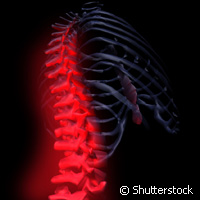Scientists discover new human pain gene
How susceptible we are to pain depends largely on the body's genetic components but information about actual 'pain genes' and their function is not readily available. Ready to piece together this puzzle was a team of scientists that investigated the relationship between pain and gene variations. They found that people with minor variations in this gene reported differences in susceptibility to acute and chronic pain. Presented in the journal Cell, the findings were funded in part by a European Research Council (ERC) Advanced Grant. Co-led by researchers at the US-based Children's Hospital Boston, the team discovered the gene in a genome-wide hunt for pain genes in fruit flies. They said corroborating mouse studies also shed light on how the gene controls pain and sensitivity. By fuelling our knowledge on the genetic basis of pain, researchers could focus on developing new analgesics for treatment, identifying risk factors for chronic pain and improving decision making about the types of surgical treatments for patients, according to the Children's Dr Clifford Woolf, a senior co-author of the study. Past studies of twins have shown that around 50% of variance in pain sensitivity is inherited. 'Across a number of different kinds of pain, genes seem to be at least half the driver of how much pain you experience,' explains Dr Woolf. 'Genes give us an amazing and powerful tool to begin to understand how pain is generated, and which functional pathways and specific proteins are involved.' According to the researchers, the new gene encodes part of a calcium channel called 'alpha 2 delta 3'. Calcium channels are pores in the cell membrane enabling calcium ions to pass. Nerve cells need these channels to kick-start their electrical excitability. The team conducted genetic screens in fruit flies, targeting almost 12,000 genes for mutations specifically in nerve cells. They used RNA (ribonucleic acid) interference (RNAi) technology to perform this task. Various mutant flies were exposed to noxious heat, and the team identified which flies were not able to fly away. The researchers then eliminated flies with other complications, including vision failure, and then identified the flies with mutations that were seemingly specific to pain. They found almost 600 candidate pain genes but selected alpha 2 delta 3 for further evaluation. The fact that calcium channels are a known target of various analgesics currently available helped in their decision. Professor Michael Costigan, also from Children's, and his colleagues determined the gene's role in human pain sensitivity by assessing four single nucleotide polymorphisms (SNPs) or single-letter variations in the DNA (deoxyribonucleic acid) code, within or close to the alpha 2 delta 3 gene in 189 volunteers without any health complications. Based on the results, some less common SNPs were linked to lower sensitivity to acute pain in a test administering a quick series of noxious heat pulses. More tests on 169 patients who were treated for pain brought on by herniated vertebral discs showed that patients with these less common SNPs were not expected to suffer from persisting chronic pain. The researchers plan to investigate the other pain genes identified in the fly screen. Experts from Germany and Austria made key contributions to the study. Meanwhile, the latest 'Pain Proposal European Consensus Report', which was drafted by experts and policymakers in Europe, highlights how 21% of Europeans with chronic pain cannot work, and of those who do work, 61% feel the pain is affecting their employment status. The report also shows how chronic pain is costing Europe close to EUR 218 billion each year, with 90% of the burden falling on employers, families and taxpayers.
Countries
Austria, Germany, United States



